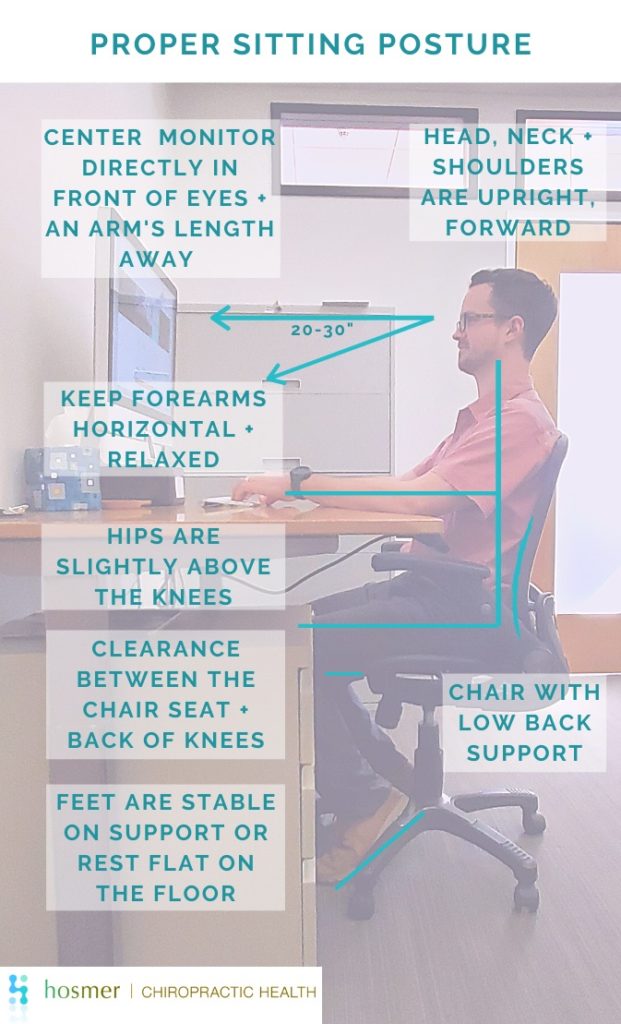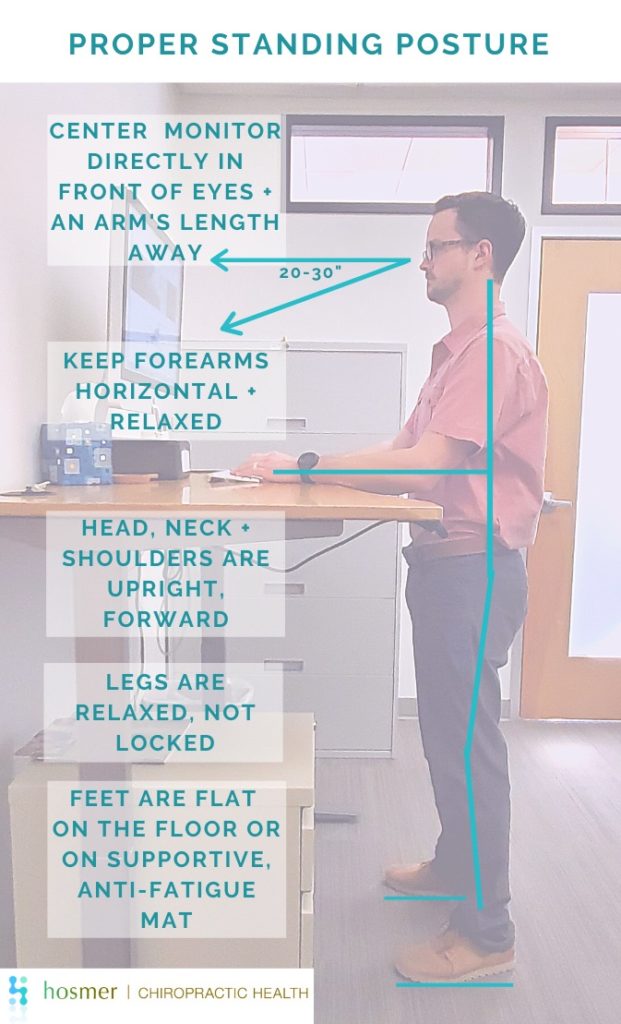Working from home? Why not set up for success?!
While working at home has its potential benefits, one major drawback is not having a proper workstation to work from comfortably! So, we are here with some tips to help those newly adapting to remote work create the most ideal ergonomic home set-up. We recommend your new work area be at the kitchen table or counter as opposed to sitting on the couch.
We’ll also show you some stretches for those much needed mini-breaks to increase your productivity and keep your sanity throughout the day as we go! Keep in mind, that the ideal situation would be to vary your position about every hour throughout the workday.
IDEAL WORKSTATION SET-UP
- Posture – Sit or stand tall with your ears over your shoulders. Shoulders relaxed and elbows bend to approximately 90 degrees. Use a small pillow or rolled up blanket for added low back support.
- If you are on the phone all day, use a headset instead of trying to cradle the phone between your ear and shoulder. Your neck will thank you!
- Monitor – Optimally, the middle to top of the computer screen should be eye level and centered in front of you. Use a stack of books or yoga blocks to accomplish this if necessary.
- Keyboard/mouse – Bring the keyboard and mouse towards you as opposed to reaching out for it. With shoulders relaxed and elbows bent you should be able to reach the keyboard. If you are using a laptop, use a separate keyboard and mouse so you can have your screen at eye level and your mouse and keyboard at elbow level.

MAINTAINING GOOD POSITION
Once you’ve got the perfect workstation set-up all you have to do is sit, right? Wrong! Getting your workstation set up correctly is only half the battle. You now have to maintain that posture. Here are a few tips and tricks to making the most out of your new workstation.
GOOD POSTURE IS HARD WORK

Proper posture may feel awkward and tiring for a while. If you have been sitting with less than ideal posture for years, it’s going to take some time to develop new habits. You are going to be using muscles that haven’t been used in a while and it’s going to take time for them to strengthen and adapt to new positioning. One of the biggest complaints from people trying to make some of these changes is that they get tired, sore, and are unable to maintain their position. This is perfectly normal!
Just like any exercise program, the best way to combat this is through slow progressive steps. Start easy by consciously sitting or standing with good posture for just one minute. Once that becomes easy, increase the time to two minutes and so on. It’s going to take a few weeks for you to build up the strength and endurance to maintain this position for an entire day.
BE MINDFUL
Proper posture is one of the easiest things to learn, but one of the hardest things to maintain. Posture is one of those annoying things that you have to constantly practice until it becomes a new ingrained habit.
Yes, it is hard.
Yes, it takes time.
Yes, it is one of the cheapest and easiest things you can do to maintain long-term spine health.
Yes, we know you are busy – everyone is. Find time because after all, it’s your body and your health.
The key to success is simply finding a way to remind yourself to check your posture and breathing on a regular basis. One thing that many patients find helpful is setting an alarm on their phone that goes off every hour that reminds them to sit up straight and breathe. Or better yet, when the alarm goes off get up and move around for five minutes and then reset at your workstation.
Oftentimes tying it to another ingrained behavior will increase your chances of success, such as resetting your posture every time you check your email, or checking your breathing mechanics every time the phone rings. It doesn’t matter how you do it, but find a way to remind yourself multiple times a day. The good thing is that the more you do it, the easier it becomes, and soon you won’t even have to think about it.
Finally, and most importantly TAKE A BREAK AND MOVE!!
JUST BREATHE!!
Make sure you are breathing correctly. One of the quickest ways to sabotage good posture is to take short shallow breaths with your chest. This breathing pattern is not only inefficient, but also will fatigue the postural muscles that are already working hard on keeping you sitting upright. For a detailed explanation of proper breathing mechanics, please see our video on breathing or our other blog post on proper breathing and bracing techniques.
STANDING DESKS
Standing desks are great for decreasing stress on your lower back and improve ergonomic positioning at the workplace. They can help to decrease hip flexor tightness and decrease pressure placed on your lumbar discs. However, you can still slouch when you stand. This means that the above tips still apply to a standing desk! If you don’t have optimal set up, you lower back may benefit, but your neck and shoulders may still hurt.
Choosing your health doesn’t have to break the bank, either; check out this list of adjustable desks that the researchers at Consumers Advocate have put together to see some of the options out there. Now that you’ve been sitting for a while reading this article, get up and try a few of these stretches offered below!
THE KEY IS MOVEMENT!
Standing 100% of the day is not optimal either. We typically fatigue and begin to kick one hip out, place all our weight on one leg if we stand too long. Aim for a balance between sitting time and standing time. Even with the most ideal standing or seated posture, it is still important to get up at least once an hour and move. The body was not designed to stay in the same position for prolonged periods of time, and the best thing you can do is give it a rest.
This can be as easy as getting up to get a cup of coffee, walking the dog, or doing some simple stretches. Even if you are swamped and can’t take long breaks, standing up and stretching for a few seconds will still feel good. Anything you can do to break the monotony of any one position will have positive effects on your body!
WE’RE HERE TO HELP!